over 1 year
ago -
PDXRyagi
-
Direct link
Hello everyone, and welcome back to EUIV Dev Diaries! It’s been a while since the last one, but we come with renewed enthusiasm and energy, especially after having celebrated the 10th Anniversary of the game. It’s been great to notice how big and strong the community is after a decade, and we’re very glad about the reception of the different activities that the CM Team has been deploying in the last month. Kudos to them, as well!
During the summer we’ve also been busy planning, designing, and implementing new content for the game. We still have a bunch of ideas even after the massive amount of content that was added in EUIV: Domination, and we think that we can keep improving the game, even after its longevity. Our objective for the next update will be to further raise the quality of the game while finishing fixing and balancing the post-release issues from 1.35.
In that regard, the topic of the next DLC will be new regional content. And the region that will receive it is the Middle East, something long awaited by the community! Then, we’re ready to reveal that it will be released in a new Immersion Pack, Europa Universalis IV: King of Kings, which can be wishlisted today.
That said, now my colleague Ogele will present to you the first pieces of new content for this new DLC, and the coming update 1.36. I hope you enjoy it!
---------
"Iran's glory has always been its culture." - Richard Nelson Frye in Greater Iran, A 20th-Century Odyssey.
With this quote, I welcome you all to our first Dev Diary for 1.36, which will be focused on Persia. I don’t think there is much of an introduction needed for it, as it is a country that the community has been actively requesting to receive an update, especially after the Great Powers update of EUIV: Domination. It’s been an easy pick for us to work on, as it already had been in our plans for a while! So let’s get started by taking a look at the historical founder of the Safavid Dynasty: Ardabil.
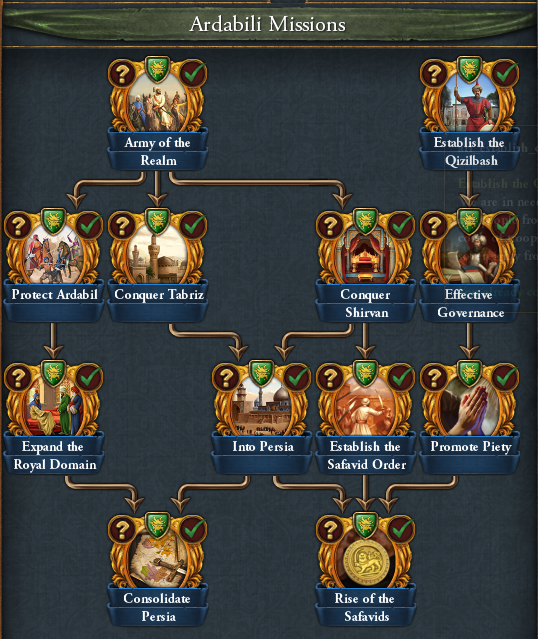
[Note: All the screenshots shown in the DD are a work in progress, as usual!]
The Ardabil tree aims to help the player to unify the region. You gain permanent claims on the Tabriz and Shirvan areas, a core on the Tabriz province itself (once you have conquered the area first), +3 development in every province in the Tabriz area (a note about this, Ardabil province is now part of this area), and a religious CB against heathens and heretics for 25 years.
A common complaint on the forums was that missions simplify hard tags too much, and as such we have also decided that Ardabil will not get many of these, in order to keep the initial years as rather tough still - at least from a mission perspective.
The highlight of the tree is the mission “Into Persia” which is completed after conquering 15 provinces in Persia:
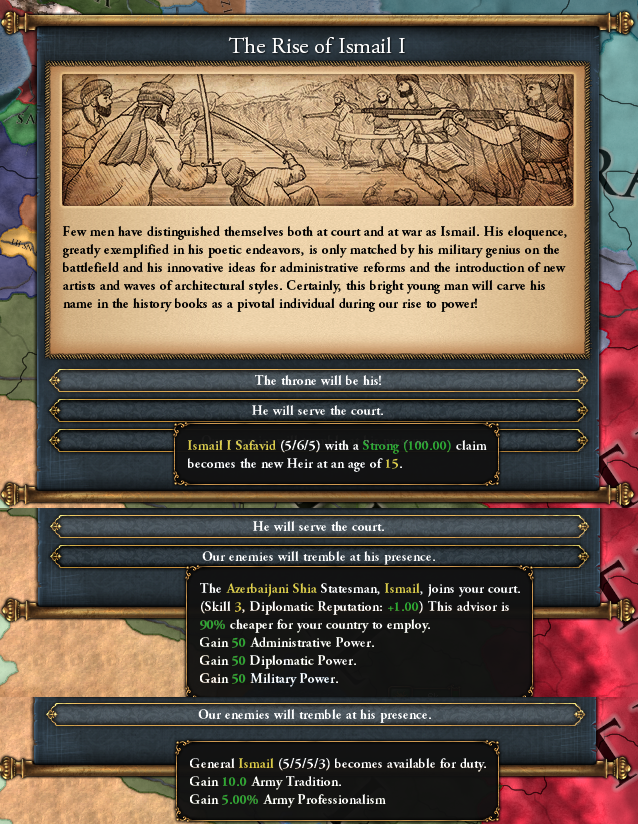
Another thing unique to Ardabil is the Safaviyya Holy Order, that you can promote in your areas:
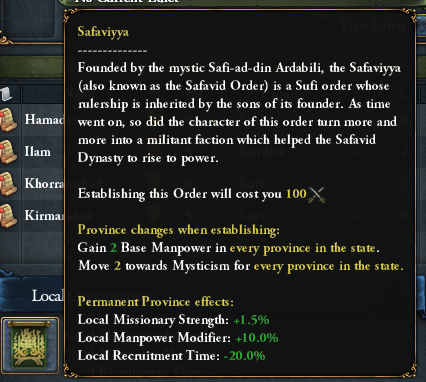
Twice as expensive as normal orders, but it comes with one additional Base Manpower too.
Now that Ardabil has been covered, let us focus our attention on the religious setup of Persia as this affects the content of the country. The setup has been adjusted to reflect history a bit better. As such, many (but not all) Shia provinces are Sunni now as the conversion of the region happened massively only after Ismail established the Safavid dynasty in the region early in the 1500s:
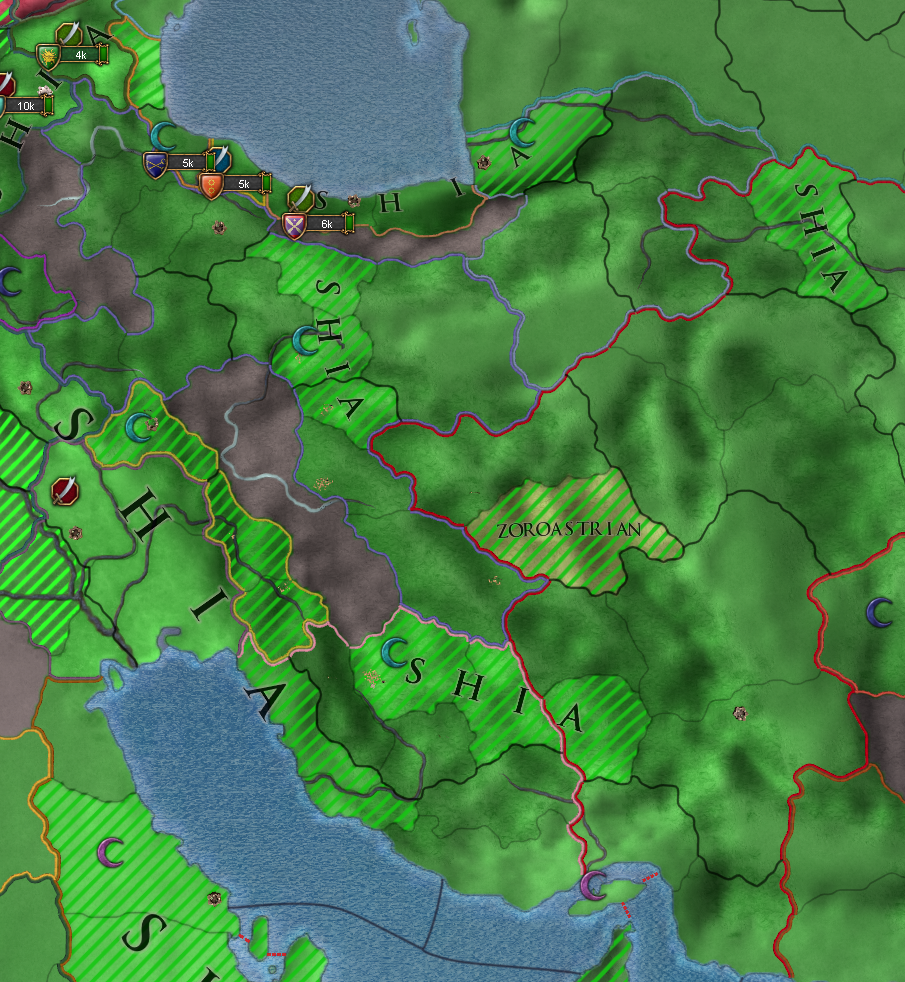
With this out of the way, let us get to the gritty details of the tag of Persia itself. First thing first, the Persian ideas have been slightly adjusted to keep them more on par with their Ottoman and (sometimes) Mughal neighbors:
The next point is the long-awaited mission tree:

With 51 missions in one playthrough, the Persian mission tree is the second largest of this update (the biggest one has 55 missions, but that is something for a Dev Diary to come ;)) and has a lot of different tasks to fulfill.
The Persian tree is split into four large packages and one small segment. As usual, I will start with the more common types of missions first and go to the more interesting ones down the line.
Starting at the top, the “Consolidate Persia” and “Secure Khorasan” mission packs here are quite self-explanatory as they are about unifying the Persia, Caucasia, and Khorasan regions, as well as conquering your way to Anatolia, Egypt, and India - all regions which were either historically conquered by one of the predecessor states of Safavid Persia like the Caliphates, or were the territory of the Persian rivals such as the Ottomans and the Mughals. The probably biggest highlights are the claims (not permanent ones though) on the Balkans and the Indian subcontinent, marking the furthest your expansion goes with the mission tree alone.
A bit more interesting are the “Origins and Legacy Missions”. In the screenshot, Persia has been formed by Ardabil, and as such you have “Expand the Safavid Order” and “Legacy of the Safavid” as the missions at the top. These are tailored to the founding nation of Persia, and as such are granted only to a handful of tags in the region who would most likely form Persia. What makes them so special are the requirements as they play heavily into the theme of your predecessor, as well as the reward from the Legacy mission.
For example: as Ardabil formed Persia, your two missions are about placing more Safaviyya Orders (of course with appropriate fallback) and converting provinces and countries alike.
As a reward, you get the following event:

Three other origins/legacy sets are added, which are for the following tags:
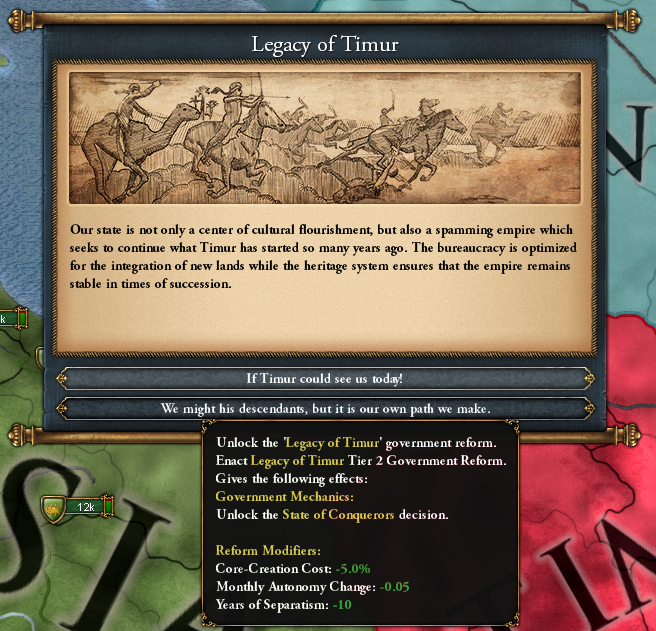

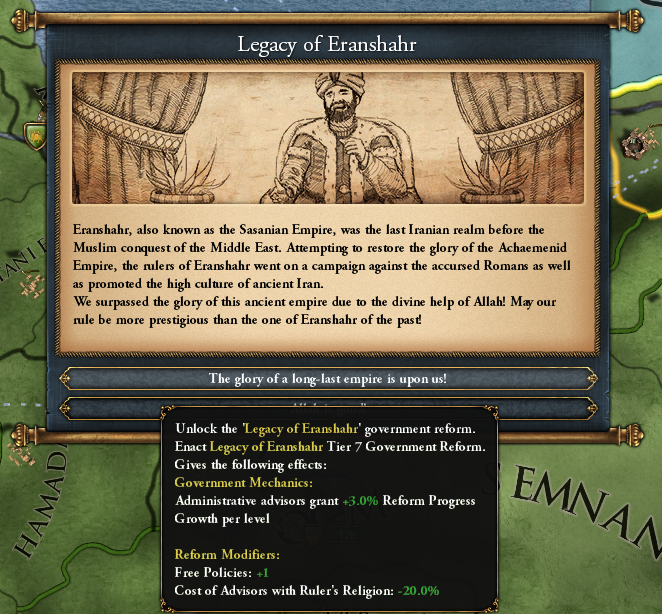
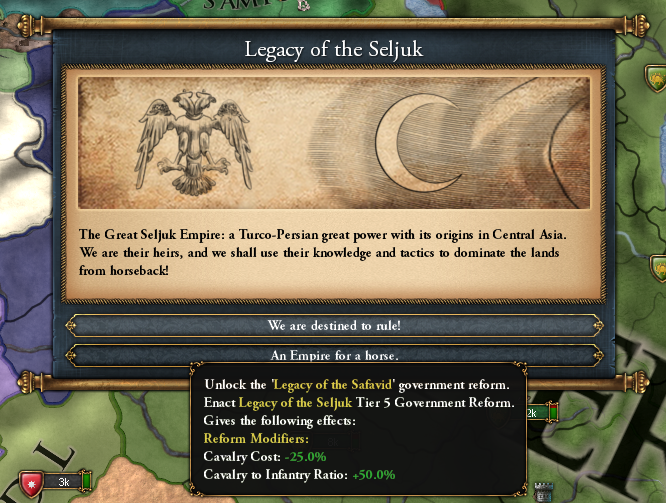
Note: missing in the picture is the access to the Tribes Estate which you gain access to in the previous mission.
Now we shall skip the middle part of the mission tree and turn our attention to the more “tall part” of the mission tree. Starting from “Shahanshah’s Coffers”, the missions will require you to invest in the development and construction of the Persian region as that was the historical focus of the country in lack of any easy expansion path which would collide with the Ottomans or the Mughals.
An early highlight here is the mission “Construct Great Buildings” which unlocks the “Great Works of Iran” estate privilege for the Burghers (although take into account that this is an early draft and that it will probably be nerfed a bit after testing):
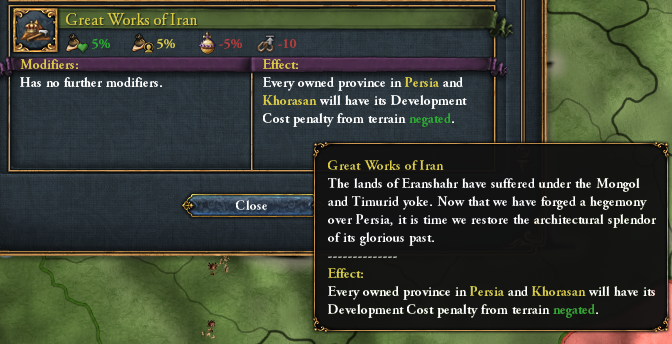
Some of its missions are shoutouts to other tall-ish missions such as “The Persian Rug” which requires you to reach a certain level of Silk, Cloth, and Dyes production in order to trigger the following event:
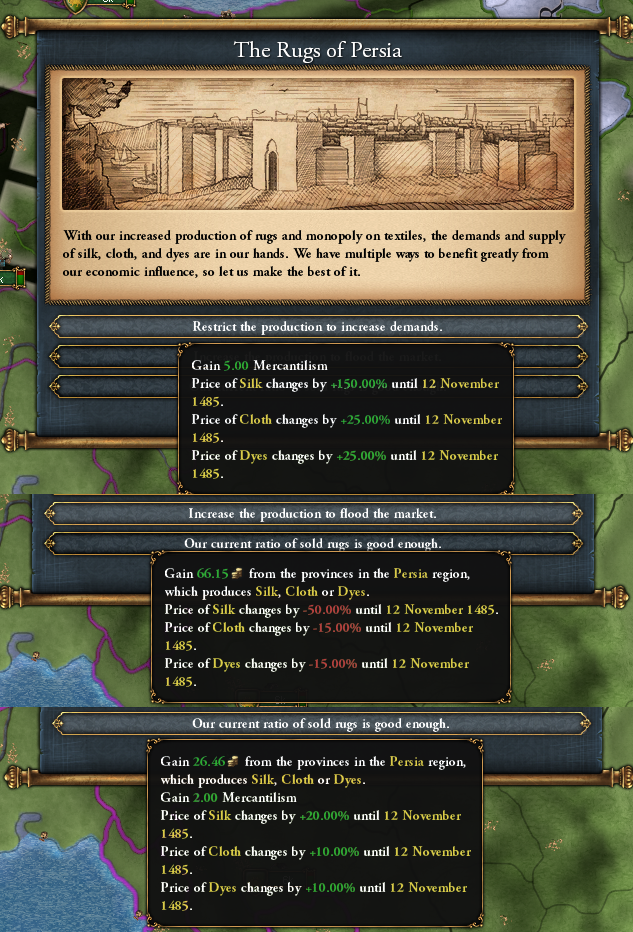
Note: The money gain in this particular image is lower than it will ever be due to me having this event fired via console commands without actually owning any low autonomy Cloth, Silk or Dyes provinces. The second option gives 5 years of production, the third option gives 2 years. As with everything here, all numbers are still WIP.
Those who played Kilwa after EUIV: Origins release will recognize the “Sino-Persian Relations” mission as it works very similarly to the “Reconnect with Persia” mission. In other words: you establish diplomatic relations with the strongest tag in China (I recommend here to wait for Ming to fall apart first, then help the Chinese Warlord whose color you like the most to unify China), and establish an Embassy in both countries’ capital which counteracts the spent diplo slot. Additionally, both you and your Chinese ally will become historical friends.
On the other side of the internal missions are the ones related to your court and culture. Highlights here are “Checks and Balance” which allows you to recruit a Grand Vizier advisor from one of your estates which has one of the Advisor cost reducting privileges:
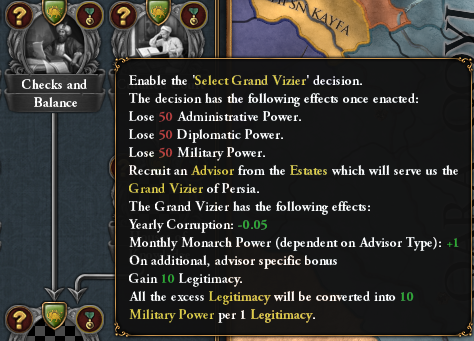
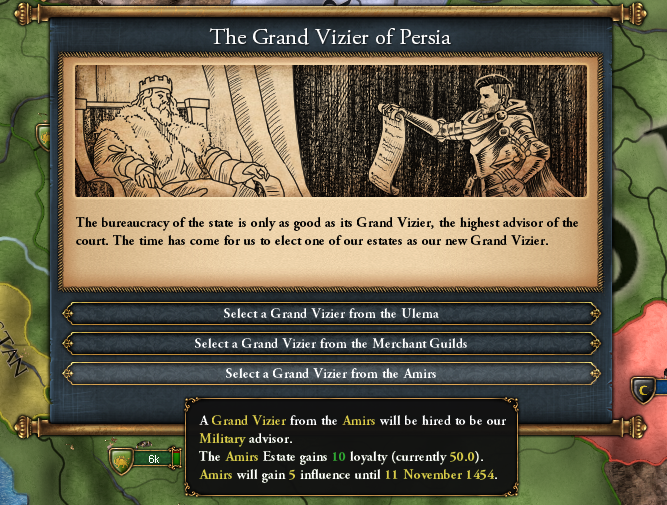
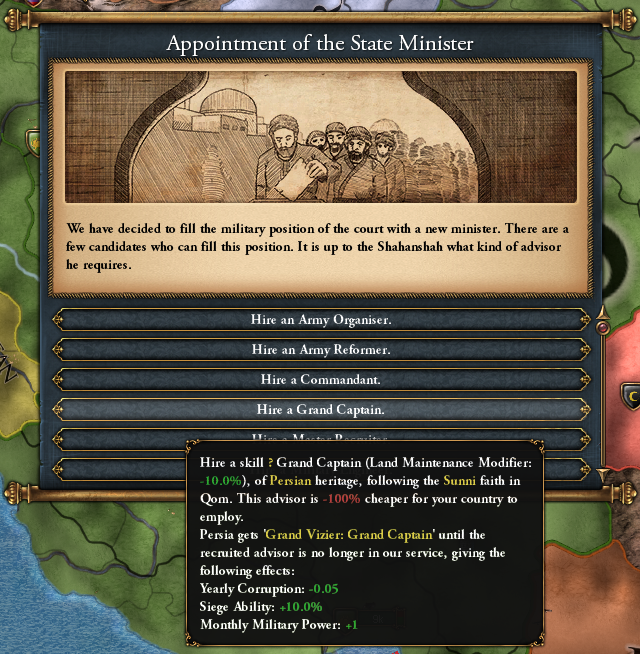
Note: We are aware of the tooltipping issue that says “-100% cheaper”. What is actually meant is that the advisor is 100% more expensive than a normal one. Also, once selected the advisor is immediately hired. If you fire him and rehire him you will not be able to get the modifier again.
Some other goodies from the Internal Missions:
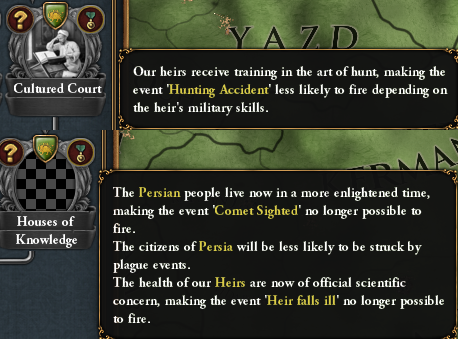
That would cover the internal missions. The next package is about the military reforms of the country. Before going into further detail, I should showcase the two new estates. Yes, two. Persia will be the only tag with more than 5 estates as a bit of an experiment. Both estates are military focused, yet they represent different branches which were put at odds with each other by the Shahanshah to ensure their loyalty.
The first such estate is one of the Qizilbash, the Turkomen cavalry and infantry of the state:


Note: all the icons are still WIP.
As you might have noticed, some of their privileges are part of the Nobility already. The nobles here won’t have access to the privileges and / or are not selectable once you have enacted the Qizilbash equivalents. So in other words: while Persia has more than 5 estates, you still can only have up to 5 “Land Rights” privileges for gov capacity, and only 1 of each Monarch Power privilege still.
In a way, the Qizilbash are intended as the “military modifiers slots” for your country, and the mission tree plays into it as you don’t get any permanent military modifiers from it but instead privileges which have their own fair share of downsides. Here are some examples:
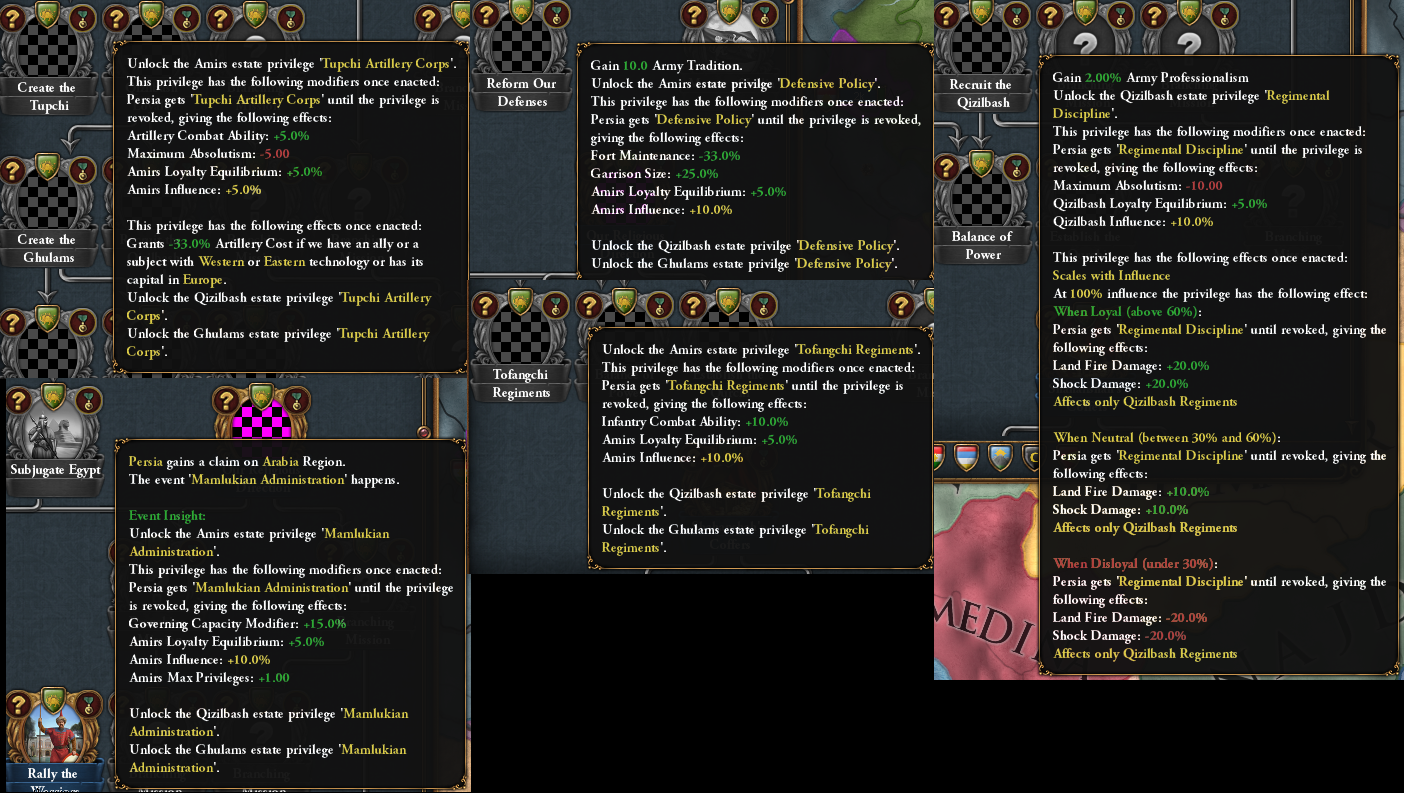
We are also toying with the idea to introduce some more Max Absolutism costs to the privileges for the sake of immersion. Anyhow, one big complaint with 1.35 was the sheer power level through mission rewards. Of course one issue is the numbers (which btw are here still WIP), but also the fact that you can collect all the modifiers and have them all active at the same time. Through privileges you are far more limited to which modifiers you can have active at the same time. Do note, it is an experimental approach to the power creep concerns, and as such is only present in Persia for now.
Also, you might have noticed that the reward for “Recruit the Qizilbash” affects only Qizilbash Regiments. Persia will have access to the Qizilbash Regiment, which in a way works very similar to the Rajputs: your Force Limit for them depends on their enacted privileges:
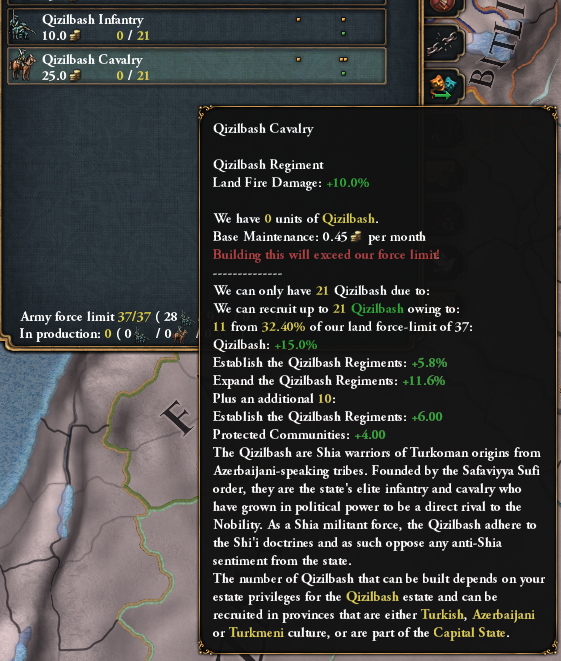
Note: Personally, I am not quite happy with their identity yet, and I am grateful to hear feedback to make them feel more unique as a special unit.
The mission “Create the Ghulams” will unlock your second (or third if you count the Nobility too) military estate:
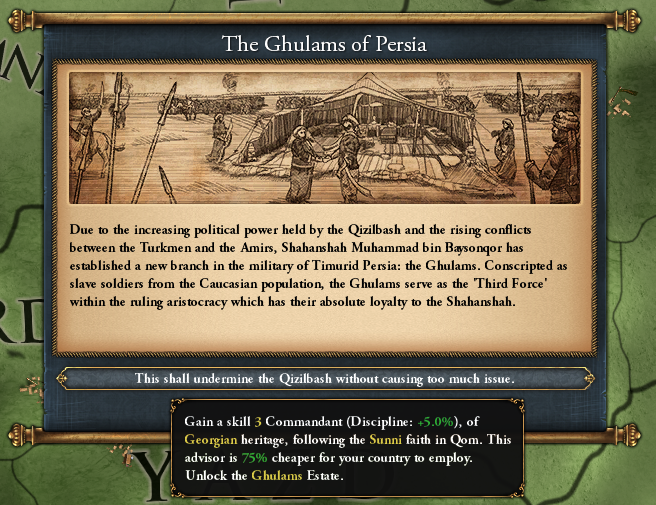
Note: They are currently called Ghulams internally, but what we actually mean are Ghilman - the plural of the Ghulam. This will be fixed soon. (Yay, a lot of ID fixes to do, that’s what ‘Under Development’ truly means to be!). But for the sake of consistency, we will call them by their singular which is Ghulam.
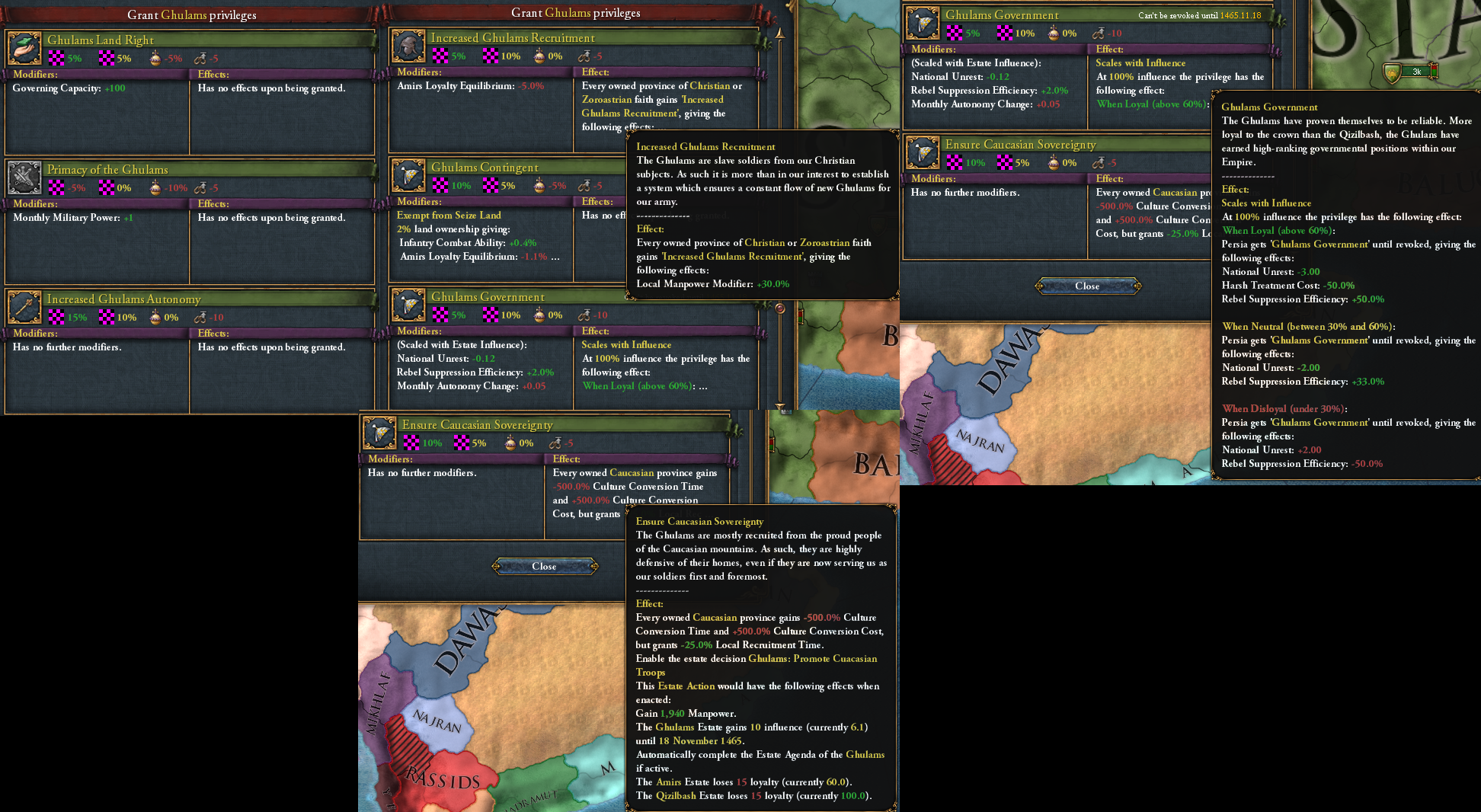

Note: Again, all icons and numbers are WIP.
The military branch of your mission tree will focus on keeping your military estates happy and completing their agendas, as well as training your troops and gaining high levels of Army Professionalism and Tradition.
Alright, I think I cannot avoid the elephant in the room anymore. Yes, branching missions are back. Still not to the extent of certain crusader hordes orders in the game, but still in a more significant number. Of course these missions are about the religious direction of Persia.
With the mission “Our Religious Direction” you will be able to choose either the historical Muslim path, or the alternative history of a Zoroastrian Persia. But before I go into more detail I want to showcase a system developed with the help of the fellow modder @Stiopa (shootout to his Mod, which he presented here[forum.paradoxplaza.com]) which makes previewing branching missions less… traumatic.
For those who have pushed away the memories, that’s how a branching mission used to look like in 1.34:

This has been changed drastically for Persia as you no longer have to hover over the mission to see what conditions / rewards you want to get. Instead, you unlock a set of buttons which allows you to freely swap around the mission trees and view them in a less painful manner:
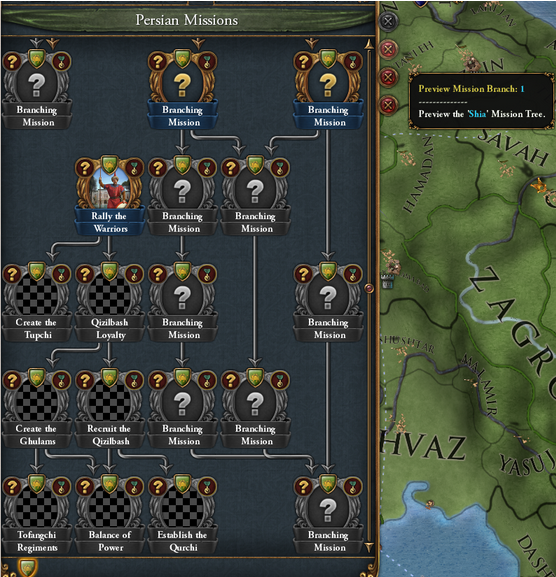
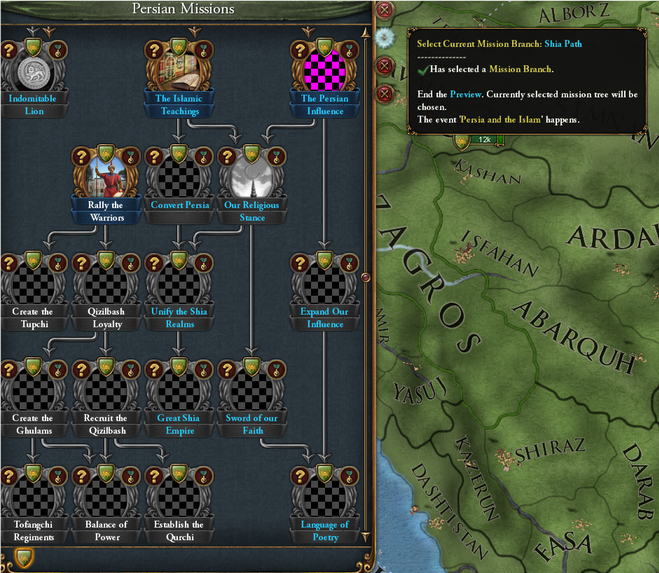
Note: The buttons for the branches are WIP. They will have a different look in the end.
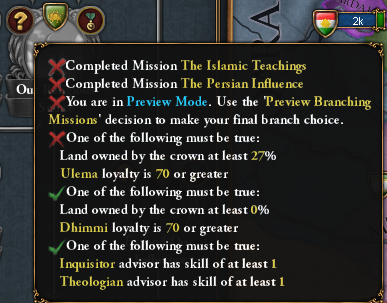
Once you have decided which path you want to pick you can select the missions you want permanently with the first button.
Now then, let us start with the Muslim path:
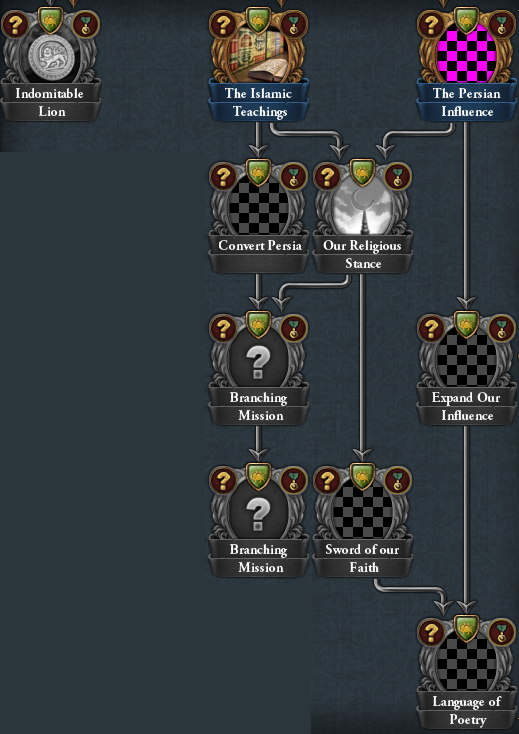
Note: This screenshot is a bit older. The branching missions within other branching missions are replaced by the ability to pick your branch the moment where you have the choice between Islam and Zoroastrianism.
The Muslim path can branch further into either the Shia or the Sunni path (Ibadi countries can do either without being forced to change their religion) - depending on which of the two branches you have picked earlier with the buttons. The Sunni missions are more expansionist as they require you to unify the Islam while the Shia missions are more tall-ish as they require you to have 1500 total development in Shia provinces. Their rewards are however the same, which is a permanent modifier +1 Tolerance of the True Faith and +15% Manpower in the Truth Faith provinces. One thing which is in favor of the Shia missions is the creation of a “Center of Conversion” for 50 years which will support you in converting the region to Shia.
Moving on, the missions dependent on “The Persian Influence” are the main bulk of the Muslim missions as they unlock a new and unique way of expansion for Persia which plays into the quote from the beginning of the development diary:
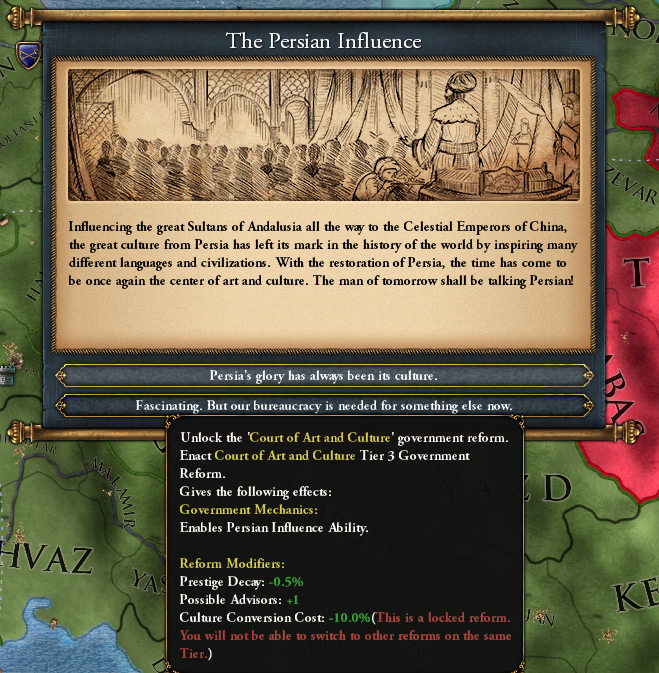
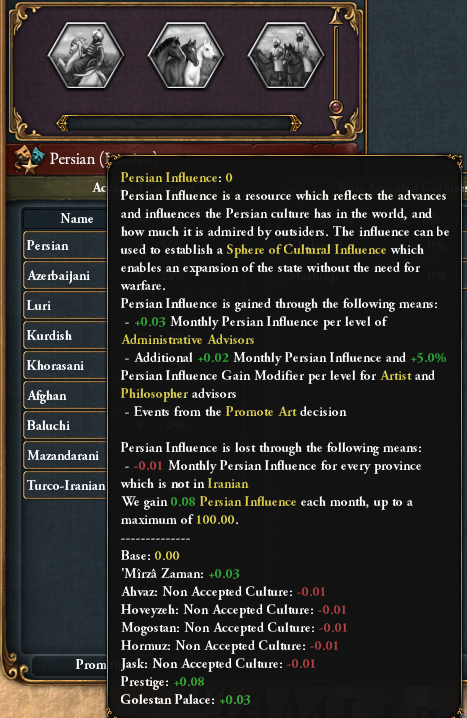
Note: Again, art is very much WIP.
The new mechanic for Persia plays into the diplomatic and especially cultural aspects of the country. You don’t only have access to a bar and three shiny new buttons, but also a few new diplomatic actions, one new peace option and a new subject type!
I will start with the diplomatic options first:
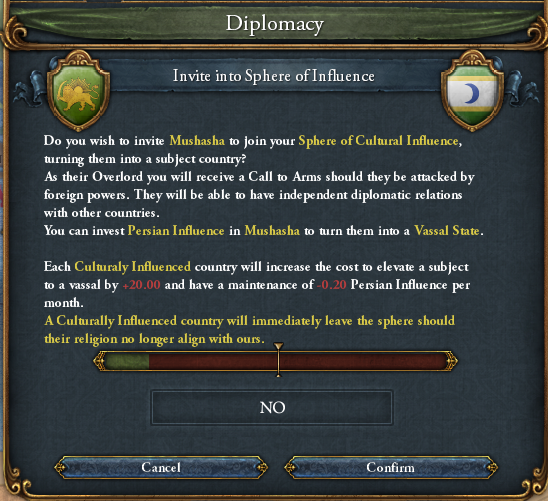
The first diplomatic action is “Invite into Sphere of Influence”. This diplo action is only usable with countries which follow your religion and are within your trade range. Countries which are great powers or have as much development as you cannot be targeted. Once they accept, the target country becomes your pseudo-subject:
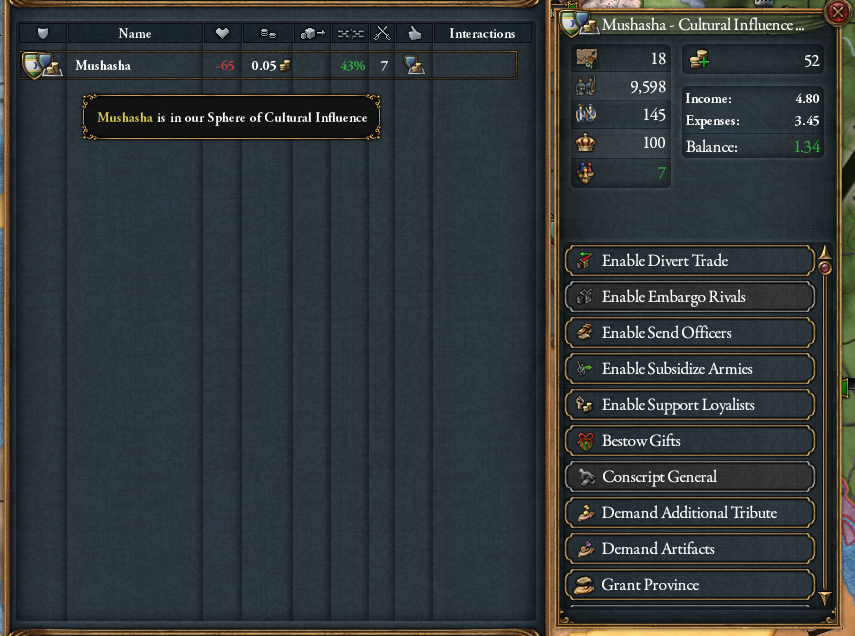
They will pay you a monthly fee which is significantly lower than that of vassals and are otherwise not very useful to you for wars or economy. You might now wonder why you would even want to bother with it then, right?
Well, you can transform these members of your Cultural Sphere of Influence into your vassals. In order to do this the target country needs your primary culture as their own too (so that means if they are not Persian, they will not accept). On Top of this, they also need to accept that request (so too much dev or too little opinion will hinder it) and they are not disloyal.
Additionally, you also require enough Persian Influence to do this diplomatic action. Every country within your sphere increases that cost by another 20 and applies a maintenance cost of -0.2 per month (numbers still WIP as -0.2 is quite limiting right now), so having too many countries at once within your sphere makes it rather difficult to elevate them to vassal status.
You also need 30 Persian Influence to promote your primary culture in their country in the first place.
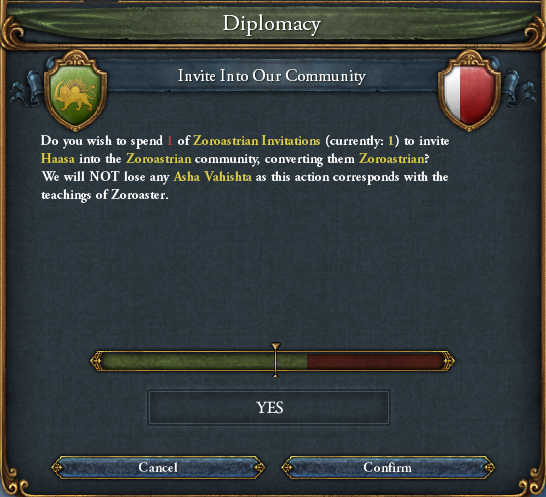
Sometimes though, war is inevitable for your sphere to grow. In these cases, the peace option “Force Primary Culture” can be of good use:
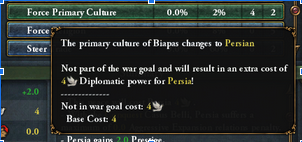
Against countries of your culture group, the warscore cost is quite cheap while the cost against countries outside your culture is comparable to Force Religion.
Now to the buttons:
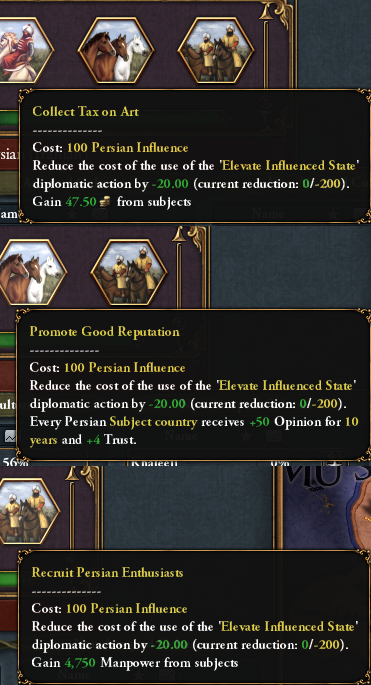
Neigh, art is not final!
While their main function is similar to the ones of the Iqta interactions, their secondary function is to reduce the elevation cost of your subjects, making it significantly easier to promote multiple countries to vassal status. The mission “Expand Our Influence” increases the max amount of reduction up to -400 and allows the creation of historical friends with your newly acquired vassals.
Now begs the question: how do you even acquire Persian Influence? While there is a passive gain of Persian Influence through good administrative advisors (especially artists and philosophers), the main generation of Persian Influence is done through the “Promote Art” decision:
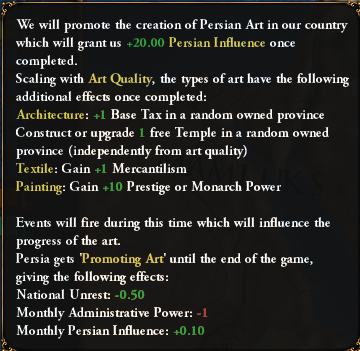
Note: Of course there is a decision which cancels the art promotion in case you need that Monthly Administrative Power more.
Once enacted, you get greeted with the following event:
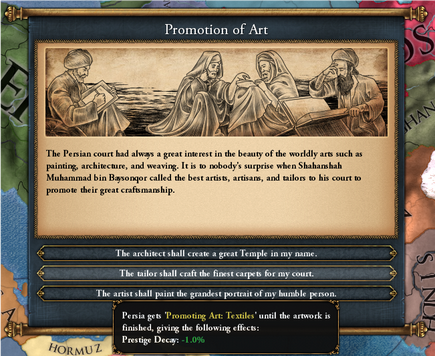
Each promoted art has its own passive modifier which will last until the work is done. While the modifier is active you receive one of these events every 2 years:

And depending on how you choose, the artist can do real wonders…
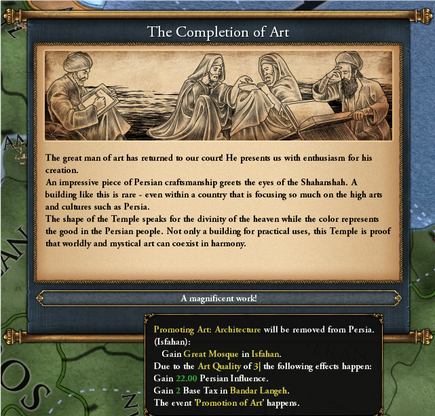
…or become a threat for everyone.

To finish the Persian Influence part of the content, the mission “Sword of our Faith” grants access to a spy action which allows you to fabricate a “Spread the True Faith” casus belli for 30 spy network. While you cannot take any provinces or make subjects, this cb allows you to enforce culture and religion at a vastly decreased warscore cost. And, finally, the mission “Language of Poetry”, which requires you to have converted 50 provinces or 15 countries to your primary culture, buffs the Persian Influence abilities by 100% and gives -10% Dev Cost in own culture provinces, -10% Advisor with Ruler’s Culture and +0.1 Monthly Persian Influence.
That finishes the Muslim branch. At last, we come to the Zoroastrian branch. The wishes for a Zoroastrian focused Persia have not met deaf ears, and as such are now their own respective path. Once you select the Zoroastrian path there will be no return from a time of a semi disaster:
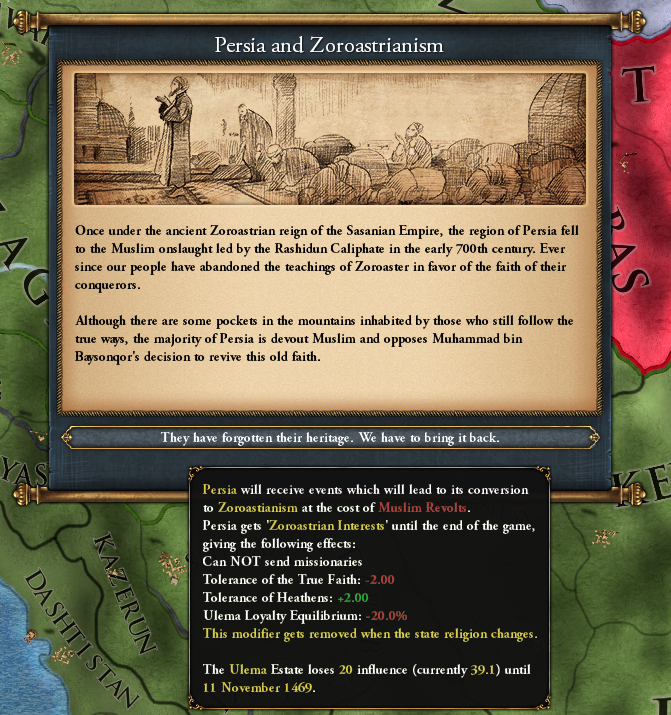
Choosing to change the religion of your country, especially when you steer away from a Abrahamic religion to a non-Abrahamic one, should feel like an impactful and, truth be told, painful experience for the state. However, due to the nature of Zoroastrianism, it is more fitting to have the conversion process done through an event chain similar to the one for the Norse religion. And so, the Zoroastrian narrative is born which you will play through unless you have chosen the Zoroastrian path while being Zoroastrian already.
I will keep the event chain rather short as the dev diary is quite large already. Here are just some of the events which will fire while your state adopts a more and more Zoroastrian world view:
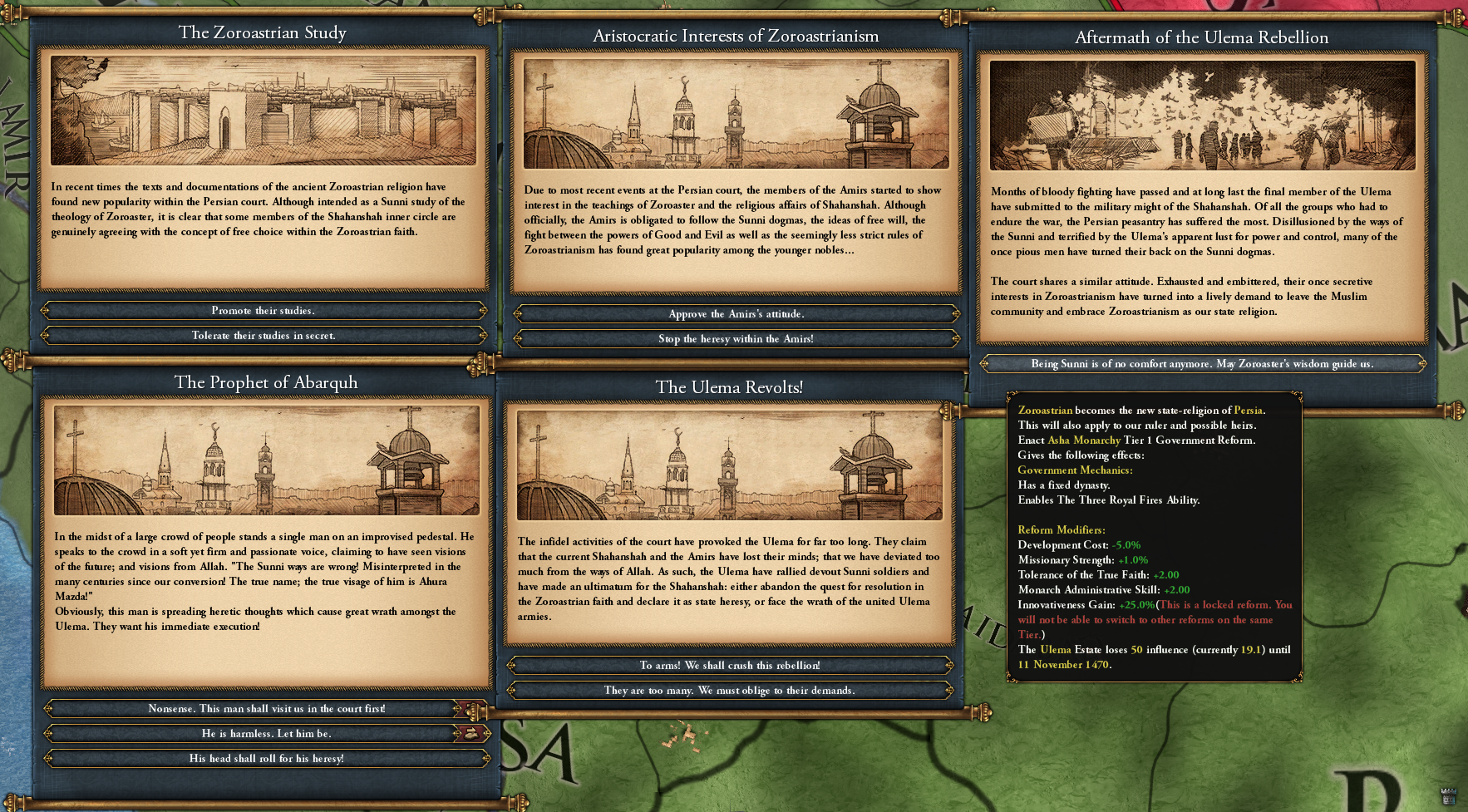
Of course you also receive new missions:
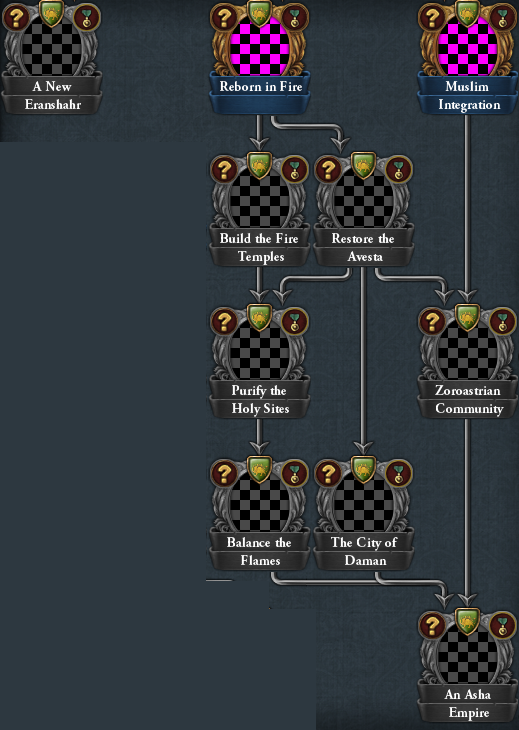
As you might have seen in the event, you get a new government reform, and with it a new government mechanic. The “Three Royal Fires” is available to all Zoroastrian countries, but Persia is the only one which gets additional support for it:
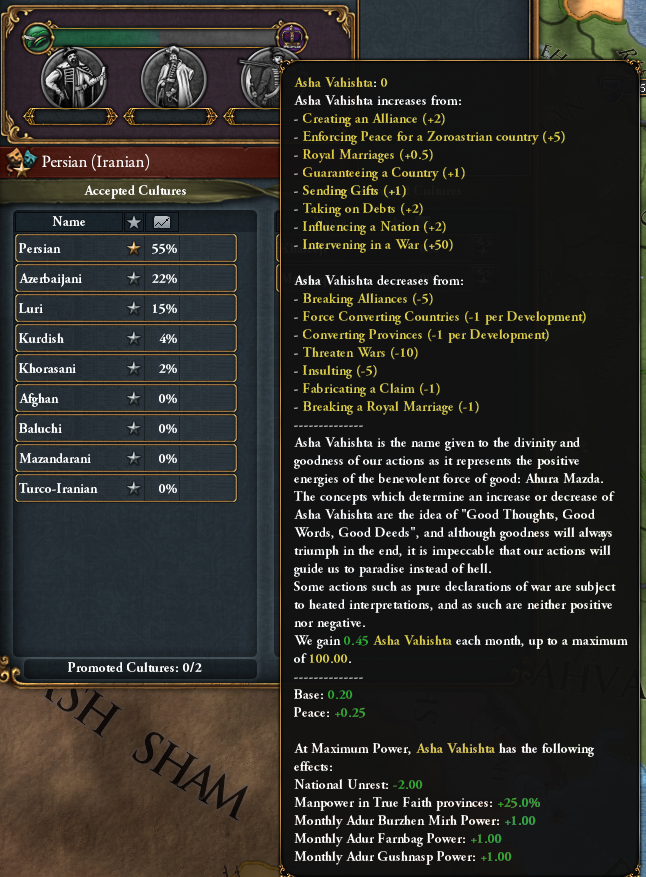
And its buttons:
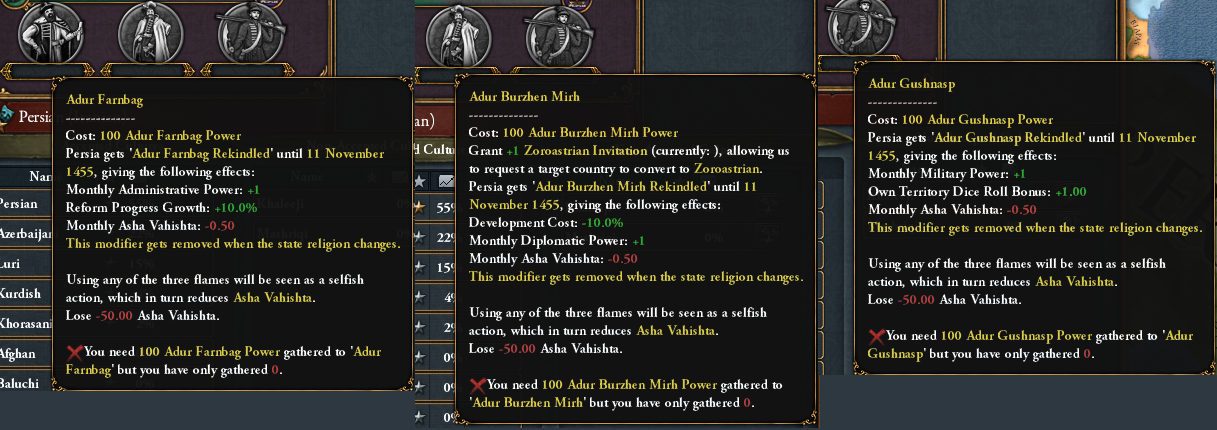
Also after becoming Zoroastrian as Persia you will receive the following event:
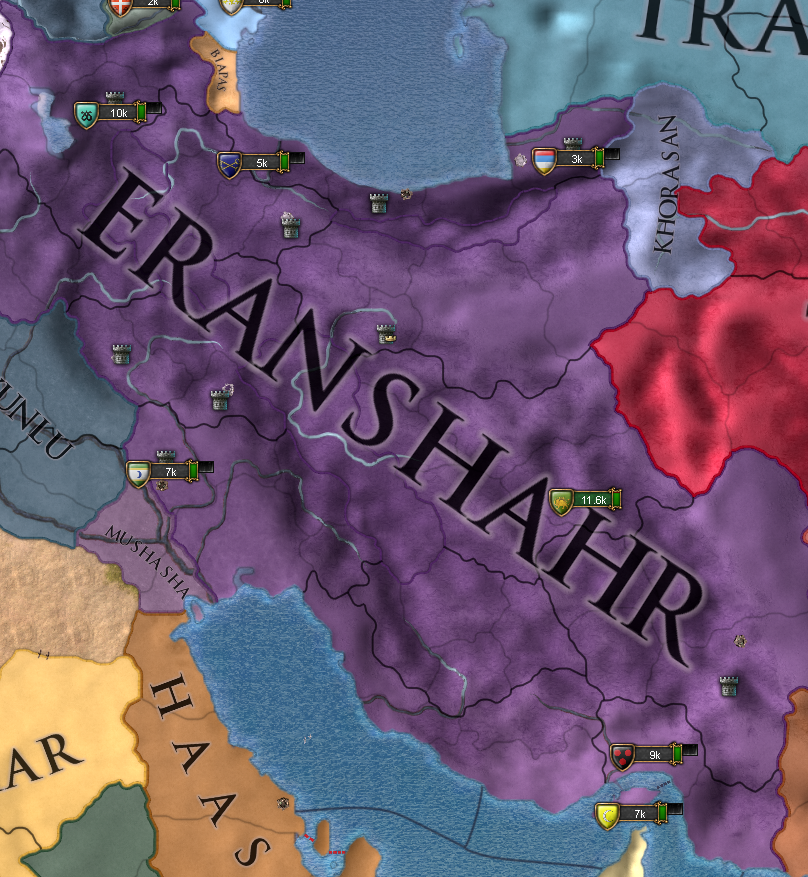
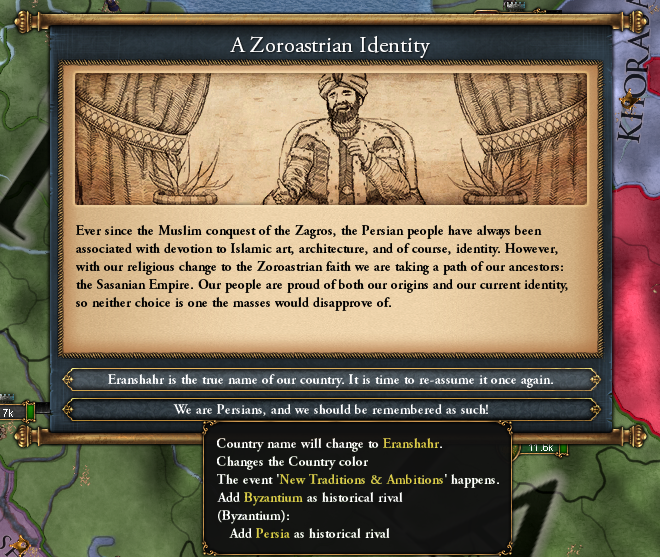
Note: Of course there are decisions which restore the old name / color.
As for the ideas, they are still WIP. I would like to hear your ideas for what Zoroastrian Persia should have in its ideas though. ;)
Moving on, the Zoroastrian missions aim at the restoration of the Zoroastrian faith and creating new allies who would like to join your newly recreated community. The mission “Reborn in Fire” will spawn a Zoroastrian “Center of Conversion” which targets the Muslim and Christian provinces in its proximity:
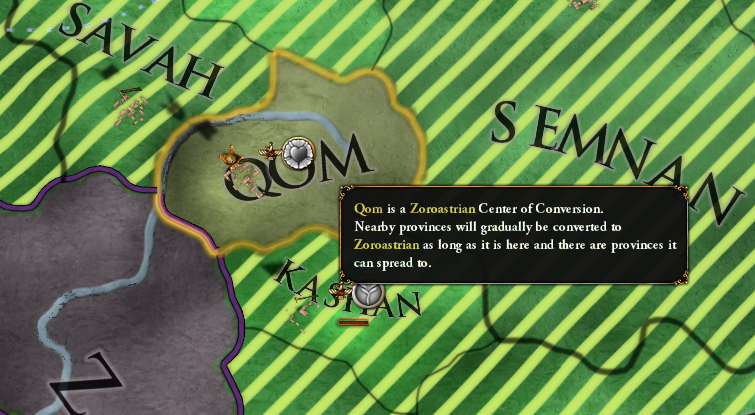
The mission “Restore the Avesta” allows you to use the Propagate Religion trade policy for another method of converting provinces while the “Purify the Holy Sites” removes the Asha Vahishta reduction from missionaries. “Balance the Flames” and “An Asha Empire” give additional buffs to your three buttons to make them quite potent:
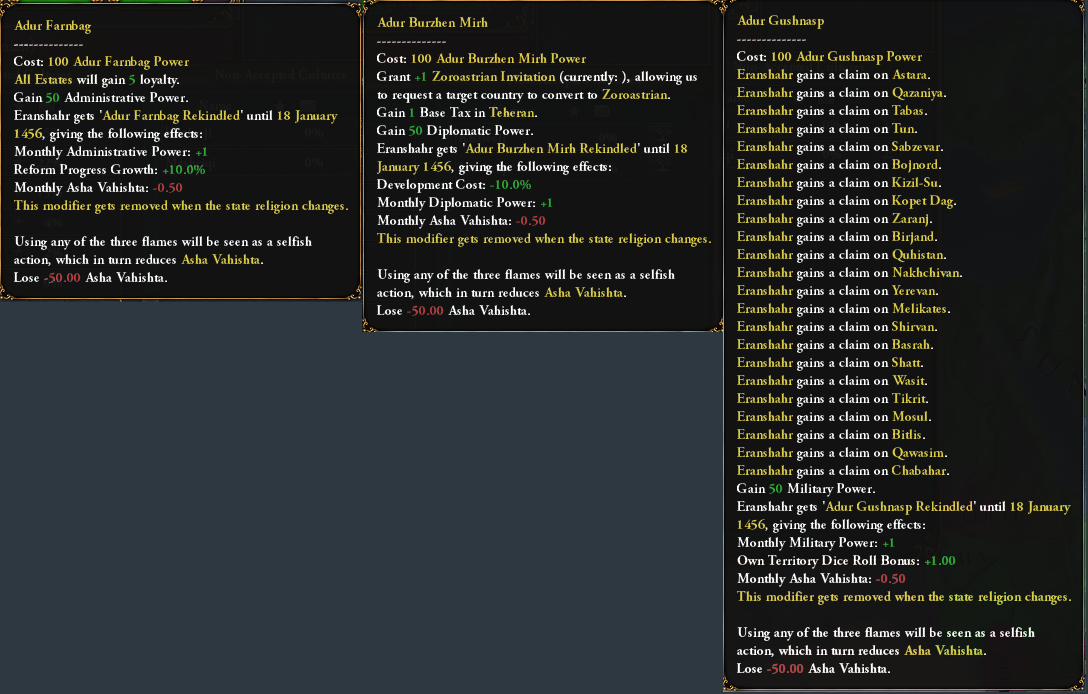
Now, that is not quite the end for Zoroastrian Persia yet. As you can see in the “Adur Burzhen Mirh” interaction you will notice the mention of “Zoroastrian Invitation”. As there are basically no other Zoroastrian countries in the world, you are free to establish your own community of Zoroastrian countries by inviting them into it:
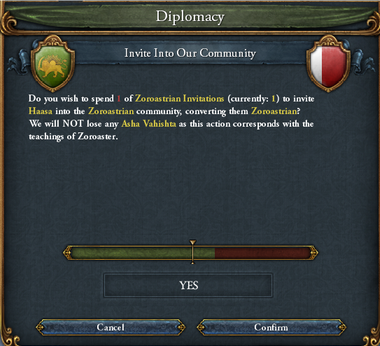
Rule of thumb here for AI acceptance: all the AI reasons why they would accept a vassalization apply here, though not as strict.
Speaking of Zoroastrianism: their blessings affect your government mechanic and it is now possible to be the Defender of Faith for the Zoroastrian religion.

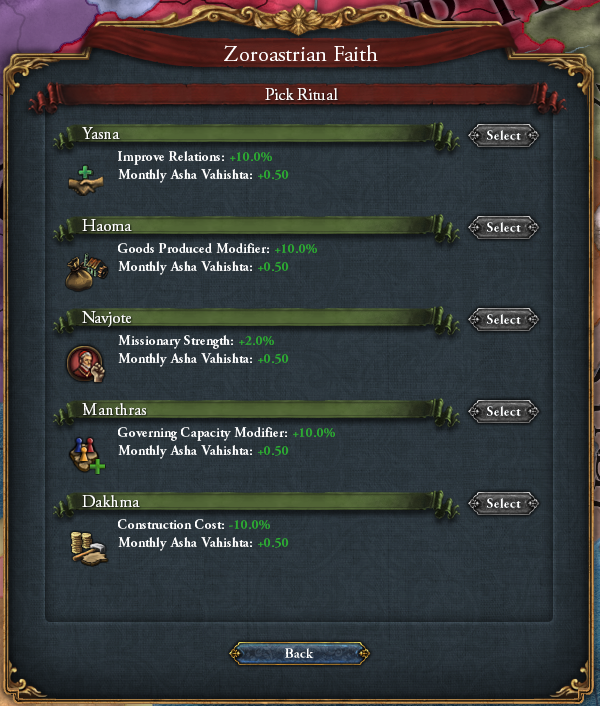
To finally conclude the Developer Diary, there will be several new flavor events added for them which trigger throughout your campaign (if you, of course, fulfill the requirements, such as
With that being said, thank you all for your time, and I wish you all a great week! And the next one my colleagues PDXBigBoss will be presenting the new content for the Mamluks! Cheers!
Don't forget to wishlist King of Kings here:
https://store.steampowered.com/app/2502910
Want to talk about all the glorious Persia playthroughs you've got planned?
Join us on Discord and share at: https://discord.gg/europauniversalisofficial
During the summer we’ve also been busy planning, designing, and implementing new content for the game. We still have a bunch of ideas even after the massive amount of content that was added in EUIV: Domination, and we think that we can keep improving the game, even after its longevity. Our objective for the next update will be to further raise the quality of the game while finishing fixing and balancing the post-release issues from 1.35.
In that regard, the topic of the next DLC will be new regional content. And the region that will receive it is the Middle East, something long awaited by the community! Then, we’re ready to reveal that it will be released in a new Immersion Pack, Europa Universalis IV: King of Kings, which can be wishlisted today.
That said, now my colleague Ogele will present to you the first pieces of new content for this new DLC, and the coming update 1.36. I hope you enjoy it!
---------
"Iran's glory has always been its culture." - Richard Nelson Frye in Greater Iran, A 20th-Century Odyssey.
With this quote, I welcome you all to our first Dev Diary for 1.36, which will be focused on Persia. I don’t think there is much of an introduction needed for it, as it is a country that the community has been actively requesting to receive an update, especially after the Great Powers update of EUIV: Domination. It’s been an easy pick for us to work on, as it already had been in our plans for a while! So let’s get started by taking a look at the historical founder of the Safavid Dynasty: Ardabil.

[Note: All the screenshots shown in the DD are a work in progress, as usual!]
The Ardabil tree aims to help the player to unify the region. You gain permanent claims on the Tabriz and Shirvan areas, a core on the Tabriz province itself (once you have conquered the area first), +3 development in every province in the Tabriz area (a note about this, Ardabil province is now part of this area), and a religious CB against heathens and heretics for 25 years.
A common complaint on the forums was that missions simplify hard tags too much, and as such we have also decided that Ardabil will not get many of these, in order to keep the initial years as rather tough still - at least from a mission perspective.
The highlight of the tree is the mission “Into Persia” which is completed after conquering 15 provinces in Persia:

Another thing unique to Ardabil is the Safaviyya Holy Order, that you can promote in your areas:

Twice as expensive as normal orders, but it comes with one additional Base Manpower too.
Now that Ardabil has been covered, let us focus our attention on the religious setup of Persia as this affects the content of the country. The setup has been adjusted to reflect history a bit better. As such, many (but not all) Shia provinces are Sunni now as the conversion of the region happened massively only after Ismail established the Safavid dynasty in the region early in the 1500s:

With this out of the way, let us get to the gritty details of the tag of Persia itself. First thing first, the Persian ideas have been slightly adjusted to keep them more on par with their Ottoman and (sometimes) Mughal neighbors:
- The Encourage Act now gives +10% Production Efficiency instead of +5%
- Promotion of Irrigation now gives -5% Development Cost and +15% Manpower Recovery Speed instead of +10% Manpower Recovery Speed
- Increase the Crown Lands now gives +15% National Tax Modifier instead of just +10%
The next point is the long-awaited mission tree:

With 51 missions in one playthrough, the Persian mission tree is the second largest of this update (the biggest one has 55 missions, but that is something for a Dev Diary to come ;)) and has a lot of different tasks to fulfill.
The Persian tree is split into four large packages and one small segment. As usual, I will start with the more common types of missions first and go to the more interesting ones down the line.
Starting at the top, the “Consolidate Persia” and “Secure Khorasan” mission packs here are quite self-explanatory as they are about unifying the Persia, Caucasia, and Khorasan regions, as well as conquering your way to Anatolia, Egypt, and India - all regions which were either historically conquered by one of the predecessor states of Safavid Persia like the Caliphates, or were the territory of the Persian rivals such as the Ottomans and the Mughals. The probably biggest highlights are the claims (not permanent ones though) on the Balkans and the Indian subcontinent, marking the furthest your expansion goes with the mission tree alone.
A bit more interesting are the “Origins and Legacy Missions”. In the screenshot, Persia has been formed by Ardabil, and as such you have “Expand the Safavid Order” and “Legacy of the Safavid” as the missions at the top. These are tailored to the founding nation of Persia, and as such are granted only to a handful of tags in the region who would most likely form Persia. What makes them so special are the requirements as they play heavily into the theme of your predecessor, as well as the reward from the Legacy mission.
For example: as Ardabil formed Persia, your two missions are about placing more Safaviyya Orders (of course with appropriate fallback) and converting provinces and countries alike.
As a reward, you get the following event:

Three other origins/legacy sets are added, which are for the following tags:
- The Timurid successors (so basically the Timurids and every tag which starts or has a Timurid dynasty on their throne; yes, the Timurids will now be able to form Persia): “Patronage of the Arts” -a reference to Timur’s passion to… collecting artists throughout his empire and bringing them to his capital-, and “Legacy of Timur,” with the following event reward:


- The Mazandarani tags (Mazandaran, Gilan, and Biapas): “Ziyarid’s Successor” and “Legacy of Eranshahr” (based on the claims to be descendants of the Sasanian Empire), with the following event reward:

- The Qoyunlus (both AQ and QQ): “A State on Horseback” and “Legacy of the Seljuk” with the following reward event:

Note: missing in the picture is the access to the Tribes Estate which you gain access to in the previous mission.
Now we shall skip the middle part of the mission tree and turn our attention to the more “tall part” of the mission tree. Starting from “Shahanshah’s Coffers”, the missions will require you to invest in the development and construction of the Persian region as that was the historical focus of the country in lack of any easy expansion path which would collide with the Ottomans or the Mughals.
An early highlight here is the mission “Construct Great Buildings” which unlocks the “Great Works of Iran” estate privilege for the Burghers (although take into account that this is an early draft and that it will probably be nerfed a bit after testing):

Some of its missions are shoutouts to other tall-ish missions such as “The Persian Rug” which requires you to reach a certain level of Silk, Cloth, and Dyes production in order to trigger the following event:

Note: The money gain in this particular image is lower than it will ever be due to me having this event fired via console commands without actually owning any low autonomy Cloth, Silk or Dyes provinces. The second option gives 5 years of production, the third option gives 2 years. As with everything here, all numbers are still WIP.
Those who played Kilwa after EUIV: Origins release will recognize the “Sino-Persian Relations” mission as it works very similarly to the “Reconnect with Persia” mission. In other words: you establish diplomatic relations with the strongest tag in China (I recommend here to wait for Ming to fall apart first, then help the Chinese Warlord whose color you like the most to unify China), and establish an Embassy in both countries’ capital which counteracts the spent diplo slot. Additionally, both you and your Chinese ally will become historical friends.
On the other side of the internal missions are the ones related to your court and culture. Highlights here are “Checks and Balance” which allows you to recruit a Grand Vizier advisor from one of your estates which has one of the Advisor cost reducting privileges:



Note: We are aware of the tooltipping issue that says “-100% cheaper”. What is actually meant is that the advisor is 100% more expensive than a normal one. Also, once selected the advisor is immediately hired. If you fire him and rehire him you will not be able to get the modifier again.
Some other goodies from the Internal Missions:

That would cover the internal missions. The next package is about the military reforms of the country. Before going into further detail, I should showcase the two new estates. Yes, two. Persia will be the only tag with more than 5 estates as a bit of an experiment. Both estates are military focused, yet they represent different branches which were put at odds with each other by the Shahanshah to ensure their loyalty.
The first such estate is one of the Qizilbash, the Turkomen cavalry and infantry of the state:


Note: all the icons are still WIP.
As you might have noticed, some of their privileges are part of the Nobility already. The nobles here won’t have access to the privileges and / or are not selectable once you have enacted the Qizilbash equivalents. So in other words: while Persia has more than 5 estates, you still can only have up to 5 “Land Rights” privileges for gov capacity, and only 1 of each Monarch Power privilege still.
In a way, the Qizilbash are intended as the “military modifiers slots” for your country, and the mission tree plays into it as you don’t get any permanent military modifiers from it but instead privileges which have their own fair share of downsides. Here are some examples:

We are also toying with the idea to introduce some more Max Absolutism costs to the privileges for the sake of immersion. Anyhow, one big complaint with 1.35 was the sheer power level through mission rewards. Of course one issue is the numbers (which btw are here still WIP), but also the fact that you can collect all the modifiers and have them all active at the same time. Through privileges you are far more limited to which modifiers you can have active at the same time. Do note, it is an experimental approach to the power creep concerns, and as such is only present in Persia for now.
Also, you might have noticed that the reward for “Recruit the Qizilbash” affects only Qizilbash Regiments. Persia will have access to the Qizilbash Regiment, which in a way works very similar to the Rajputs: your Force Limit for them depends on their enacted privileges:

Note: Personally, I am not quite happy with their identity yet, and I am grateful to hear feedback to make them feel more unique as a special unit.
The mission “Create the Ghulams” will unlock your second (or third if you count the Nobility too) military estate:

Note: They are currently called Ghulams internally, but what we actually mean are Ghilman - the plural of the Ghulam. This will be fixed soon. (Yay, a lot of ID fixes to do, that’s what ‘Under Development’ truly means to be!). But for the sake of consistency, we will call them by their singular which is Ghulam.


Note: Again, all icons and numbers are WIP.
The military branch of your mission tree will focus on keeping your military estates happy and completing their agendas, as well as training your troops and gaining high levels of Army Professionalism and Tradition.
Alright, I think I cannot avoid the elephant in the room anymore. Yes, branching missions are back. Still not to the extent of certain crusader hordes orders in the game, but still in a more significant number. Of course these missions are about the religious direction of Persia.
With the mission “Our Religious Direction” you will be able to choose either the historical Muslim path, or the alternative history of a Zoroastrian Persia. But before I go into more detail I want to showcase a system developed with the help of the fellow modder @Stiopa (shootout to his Mod, which he presented here[forum.paradoxplaza.com]) which makes previewing branching missions less… traumatic.
For those who have pushed away the memories, that’s how a branching mission used to look like in 1.34:

This has been changed drastically for Persia as you no longer have to hover over the mission to see what conditions / rewards you want to get. Instead, you unlock a set of buttons which allows you to freely swap around the mission trees and view them in a less painful manner:


Note: The buttons for the branches are WIP. They will have a different look in the end.

Once you have decided which path you want to pick you can select the missions you want permanently with the first button.
Now then, let us start with the Muslim path:

Note: This screenshot is a bit older. The branching missions within other branching missions are replaced by the ability to pick your branch the moment where you have the choice between Islam and Zoroastrianism.
The Muslim path can branch further into either the Shia or the Sunni path (Ibadi countries can do either without being forced to change their religion) - depending on which of the two branches you have picked earlier with the buttons. The Sunni missions are more expansionist as they require you to unify the Islam while the Shia missions are more tall-ish as they require you to have 1500 total development in Shia provinces. Their rewards are however the same, which is a permanent modifier +1 Tolerance of the True Faith and +15% Manpower in the Truth Faith provinces. One thing which is in favor of the Shia missions is the creation of a “Center of Conversion” for 50 years which will support you in converting the region to Shia.
Moving on, the missions dependent on “The Persian Influence” are the main bulk of the Muslim missions as they unlock a new and unique way of expansion for Persia which plays into the quote from the beginning of the development diary:


Note: Again, art is very much WIP.
The new mechanic for Persia plays into the diplomatic and especially cultural aspects of the country. You don’t only have access to a bar and three shiny new buttons, but also a few new diplomatic actions, one new peace option and a new subject type!
I will start with the diplomatic options first:

The first diplomatic action is “Invite into Sphere of Influence”. This diplo action is only usable with countries which follow your religion and are within your trade range. Countries which are great powers or have as much development as you cannot be targeted. Once they accept, the target country becomes your pseudo-subject:

They will pay you a monthly fee which is significantly lower than that of vassals and are otherwise not very useful to you for wars or economy. You might now wonder why you would even want to bother with it then, right?
Well, you can transform these members of your Cultural Sphere of Influence into your vassals. In order to do this the target country needs your primary culture as their own too (so that means if they are not Persian, they will not accept). On Top of this, they also need to accept that request (so too much dev or too little opinion will hinder it) and they are not disloyal.
Additionally, you also require enough Persian Influence to do this diplomatic action. Every country within your sphere increases that cost by another 20 and applies a maintenance cost of -0.2 per month (numbers still WIP as -0.2 is quite limiting right now), so having too many countries at once within your sphere makes it rather difficult to elevate them to vassal status.
You also need 30 Persian Influence to promote your primary culture in their country in the first place.

Sometimes though, war is inevitable for your sphere to grow. In these cases, the peace option “Force Primary Culture” can be of good use:

Against countries of your culture group, the warscore cost is quite cheap while the cost against countries outside your culture is comparable to Force Religion.
Now to the buttons:

Neigh, art is not final!
While their main function is similar to the ones of the Iqta interactions, their secondary function is to reduce the elevation cost of your subjects, making it significantly easier to promote multiple countries to vassal status. The mission “Expand Our Influence” increases the max amount of reduction up to -400 and allows the creation of historical friends with your newly acquired vassals.
Now begs the question: how do you even acquire Persian Influence? While there is a passive gain of Persian Influence through good administrative advisors (especially artists and philosophers), the main generation of Persian Influence is done through the “Promote Art” decision:

Note: Of course there is a decision which cancels the art promotion in case you need that Monthly Administrative Power more.
Once enacted, you get greeted with the following event:

Each promoted art has its own passive modifier which will last until the work is done. While the modifier is active you receive one of these events every 2 years:

And depending on how you choose, the artist can do real wonders…

…or become a threat for everyone.

To finish the Persian Influence part of the content, the mission “Sword of our Faith” grants access to a spy action which allows you to fabricate a “Spread the True Faith” casus belli for 30 spy network. While you cannot take any provinces or make subjects, this cb allows you to enforce culture and religion at a vastly decreased warscore cost. And, finally, the mission “Language of Poetry”, which requires you to have converted 50 provinces or 15 countries to your primary culture, buffs the Persian Influence abilities by 100% and gives -10% Dev Cost in own culture provinces, -10% Advisor with Ruler’s Culture and +0.1 Monthly Persian Influence.
That finishes the Muslim branch. At last, we come to the Zoroastrian branch. The wishes for a Zoroastrian focused Persia have not met deaf ears, and as such are now their own respective path. Once you select the Zoroastrian path there will be no return from a time of a semi disaster:

Choosing to change the religion of your country, especially when you steer away from a Abrahamic religion to a non-Abrahamic one, should feel like an impactful and, truth be told, painful experience for the state. However, due to the nature of Zoroastrianism, it is more fitting to have the conversion process done through an event chain similar to the one for the Norse religion. And so, the Zoroastrian narrative is born which you will play through unless you have chosen the Zoroastrian path while being Zoroastrian already.
I will keep the event chain rather short as the dev diary is quite large already. Here are just some of the events which will fire while your state adopts a more and more Zoroastrian world view:

Of course you also receive new missions:

As you might have seen in the event, you get a new government reform, and with it a new government mechanic. The “Three Royal Fires” is available to all Zoroastrian countries, but Persia is the only one which gets additional support for it:

And its buttons:

Also after becoming Zoroastrian as Persia you will receive the following event:


Note: Of course there are decisions which restore the old name / color.
As for the ideas, they are still WIP. I would like to hear your ideas for what Zoroastrian Persia should have in its ideas though. ;)
Moving on, the Zoroastrian missions aim at the restoration of the Zoroastrian faith and creating new allies who would like to join your newly recreated community. The mission “Reborn in Fire” will spawn a Zoroastrian “Center of Conversion” which targets the Muslim and Christian provinces in its proximity:

The mission “Restore the Avesta” allows you to use the Propagate Religion trade policy for another method of converting provinces while the “Purify the Holy Sites” removes the Asha Vahishta reduction from missionaries. “Balance the Flames” and “An Asha Empire” give additional buffs to your three buttons to make them quite potent:

Now, that is not quite the end for Zoroastrian Persia yet. As you can see in the “Adur Burzhen Mirh” interaction you will notice the mention of “Zoroastrian Invitation”. As there are basically no other Zoroastrian countries in the world, you are free to establish your own community of Zoroastrian countries by inviting them into it:

Rule of thumb here for AI acceptance: all the AI reasons why they would accept a vassalization apply here, though not as strict.
Speaking of Zoroastrianism: their blessings affect your government mechanic and it is now possible to be the Defender of Faith for the Zoroastrian religion.


To finally conclude the Developer Diary, there will be several new flavor events added for them which trigger throughout your campaign (if you, of course, fulfill the requirements, such as
- Chinese Blue-and-White Porcelain
- Sarkhej Roza and the City of Ahmedabad
- Abbas I - Persia's Greatest Emperor
- The Two Rivers of the Fertile Crescent
With that being said, thank you all for your time, and I wish you all a great week! And the next one my colleagues PDXBigBoss will be presenting the new content for the Mamluks! Cheers!
Don't forget to wishlist King of Kings here:
https://store.steampowered.com/app/2502910
Want to talk about all the glorious Persia playthroughs you've got planned?
Join us on Discord and share at: https://discord.gg/europauniversalisofficial